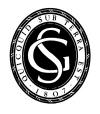

| Visitors Now: | |
| Total Visits: | |
| Total Stories: |

| Story Views | |
| Now: | |
| Last Hour: | |
| Last 24 Hours: | |
| Total: | |
A tale of three meetings
The Geological Society’s meeting room has changed a lot in the last century. Until a refurb in the seventies, it looked very much how it had done for most of its life – raked rows of benches standing opposite each other, an impressive throne (which now sits forlornly in a corner outside my office) at one end, everything geared up for a Parliamentary style set-to over the fundamentals of Earth science.
These days, the room has adopted a much more modern, lecture theatre style. To encourage discussion, not argument. Debate, but not the sort of slanging match you can still see on BBC Parliament.
Back in 1912, it was still in the old layout, and on the evening of 18 December, reportedly as full as it had ever been. As well as Fellows, no less than 74 guests had piled themselves in – most presumably relegated to the back rows, or standing. The minute book in our archives records their signatures, and those of the Fellows who signed them in. Marie Stopes put in an appearance. The fabulously named archaeologist Osbert Guy Stanhope Crawford had come up from Oxford. Gertrude Elles – a geologist whose gender still prevented her from joining as a Fellow – and Arthur Henry Lyell, grand-nephew of the late great Sir Charles, were there, as was comparative anatomist Sir Arthur Keith of the Royal College of Surgeons.
They had all come to listen to the reading of a paper which has since become the stuff of scientific legend – though not for the reasons they would have imagined at the time.
‘Several years ago, I was walking along a farm road close the Piltdown Common, Fletching (Sussex)’ began Charles Dawson, and so also began the story one of science’s most infamous hoaxes, a mystery which has cast suspicion over almost everyone remotely associated with it, from Dawson himself to Sherlock Holmes creator Arthur Conan Doyle.
A painting in our Council Room famously records the examination of the skull, with the shadowy figure of Darwin looking on, lending the scene gravitas in the story of evolutionary theory. It was painted in 1915, when Piltdown hysteria was still at its height, before the inconsistencies of the find with other supposed contemporaries relegated it to the status of an anomaly.
Dawson and his co-author, Arthur Smith Woodward, read a paper on that evening which described the discovery of a skull, which they suggested dated from the early Pleistocene, whose ape like jaw and human skull represented the ‘missing link’ between the species. Piltdown man, or Eoanthropus dawsoni (“Dawson’s dawn-man”) was the oldest known Englishman.
The story was an immediate sensation. It tapped into a more general public fascination with our earliest ancestors – Doyle’s ‘Lost World’ had just finished its serialisation in The Strand, and the nation’s consciousness was full of the idea of our deep past being preserved in the rock record.
41 years later, another group of Fellows and guests were gathered in the same room, still in its Parliamentary layout (though the ban on women Fellows had long since been lifted). Both Dawson and Woodward had died in the intervening years, and the Piltdown skull, once thought revolutionary, had lost its importance to anthropologists. Too many other finds had been made which told a story Piltdown didn’t fit with.
At that meeting, in November 1953, Kenneth Oakley of the Natural History Museum, Wilfred Edward Le Gros Clarke and Joseph Sidney Weiner, both at Oxford, described the results of their investigations. The Piltdown skull was a hoax, and a pretty crude one at that. The skull was human, but dated from medieval times, whilst the ‘ape like jaw’ was in fact a 500 year old orang-utan jaw. The bones had been stained with a solution of iron and chromic acid, and microscopic examination had shown file marks on the teeth – which were from a chimpanzee – presumably in order to make them appear more suited to a human diet.
Another 49 years on, and 100 years since the hushed excitement of that first meeting, we’re holding another, in the same room – though you wouldn’t know to look at it. As on both of those occasions, some of anatomy and anthropology’s biggest names are attending. As on both of those occasions, the Piltdown skull and its story is the focus.
This time, we’re re-examining the fraud, and discussing the various suspects. Dawson is prime, of course, but fingers have been pointed at a host of others. A team at the Natural History Museum has been looking again at how the specimens were created. Can they tell us something about who was involved? And what is the relevance of the story, so long after the hoax was exposed?
There are those who will say the story of Piltdown is irrelevant now. All the suspects are dead, and the specimen never had the effect on science which – presumably – the perpetrator hoped it would. Visitors sometimes ask why the painting still hangs in such a prominent place here. But Piltdown remains a popular story, and an important one. It is a cationary tale for scientists, or anyone, eager to find that one piece of a puzzle which will make everything fit. Those finds rarely exist. History is rarely so tidy. In the history of this Society, the ‘Piltdown affair’ remains a tale worth telling.
- ‘Piltdown: 100 years on’ is on 18 December at the Geological Society of London, and open to all. Visit www.geolsoc.org.uk/Events/Piltdown for more information, or follow us on twitter on the day using #Piltdown100
![]()
2012-12-13 13:03:46
Source: http://blog.geolsoc.org.uk/2012/12/13/a-tale-of-three-meetings/
Source:








